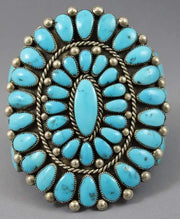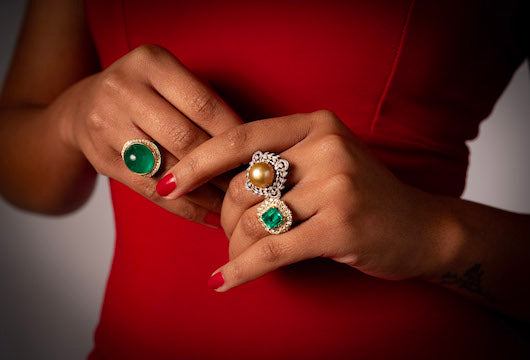The traditions and legacy of the Zuni tribe extend thousands of years, deep into the roots of New Mexico’s history. The Zuni are a small tribe consisting of approximately 10,000 members that for millennia have made their home in the high desert surrounding the Zuni river. While today the tribe is most famous for their intricate inlay, fetish, and petit point jewelry, the Zuni have created jewelry pieces with symbolic significance for members of their own and other tribes since their inception.
The earliest Zuni artisans used tools made of stone and antler to fashion designs made from native materials, such as deer antler, spiny shell oyster, red shale, freshwater clam, and abalone.
They also carved fetish pieces, or animal carvings, from single pieces of stone that were treasured among members of their own tribe and others alike for their protective qualities.

Typical Zuni pieces today consist of brightly colored coral or turquoise clusters of petit point stones set in complex, delicate patterns. Photo courtesy of Audie Yazzie.
The History of Contemporary Zuni Jewelry
In the 1870’s The Zuni were introduced to more contemporary Native American jewelry design by the Navajo. The earliest pieces of Zuni jewelry from this era were simple, hand-wrought silver sometimes lightly embellished with rocker engraving or die-stamping. By 1890 they began to include turquoise in their work, emulating the work of the Navajo. With the exception of the addition of turquoise, the overall stylistic elements of Zuni pieces exhibited relatively little change over the next few decades. At this time, most Zuni pieces were still created primarily for Zuni, Navajo, and other Native American tribes.
In the early 1900's C.G. Wallace opened a trading post in the Zuni village. Wallace hired many Zuni artists, encouraging them to incorporate brightly colored coral and turquoise into complex cluster designs for sale in the tourist trade. Within a few short decades of Wallace’s influence, most Zuni pieces were created for the tourist industry. Jewelry making had become a significant source of income for the Zuni people, and needlepoint, petit point, and inlay designs became strongly associated with the Zuni aesthetic.
Today, approximately 50%-75% of Zuni tribal income comes from the sale of arts and crafts. The concentration of skilled craftspeople within the tribe cannot be overestimated and is most likely the highest number among any of the Native American nations.
Zuni Jewelry Styles and Hallmarks of Design
Zuni jewelry is best known for its intricate, delicate stonework, mosaic inlay, and stone animal carvings. The most widely recognized styles include petit point, needlepoint, inlay, and fetish.

Unlike the collection of petit point pieces shown in the earlier image, needlepoint cluster designs like the bracelet above are characterized by long, thin, needle-shaped stones. Photo courtesy Audie Yazzie.
Petit Point vs Needle Point
Both petit point and needle point pieces are characterized by finely cut clusters of turquoise, coral, and other gemstones set in complex round or oval patterns that resemble wheels, snowflakes, and bows.
The difference between the two lies in the shape of the gemstones. Petit point is made up of tiny round, oval, square, or teardrop shaped stones laid individually in their own bezels in a detailed pattern. Needle point echoes the same thematic elements and overall composition, but the gems are cut into long, slender pieces resembling a needle in appearance. Typically, if the stones are not long and needle-shaped, the design is considered to be petit point.

Beautiful contemporary Zuni inlay bracelet by Colin Coonsis. Photo courtesy of Audie Yazzie.
Inlay
Inlay is a technique in which many stones are fitted tightly together to form a single image. Brightly colored stones are set into silver channels made by soldering strips of silver to a backing plate. The pieces are usually finished by polishing the stones flat, resulting in a beautiful geometric design made up of brightly colored gems like onyx, turquoise, and coral interspersed with veins of silver.
Different techniques of inlay are used to achieve different effects. Channel inlay means that each stone is set in its own silver compartment, plain inlay results in stones placed tightly side by side with no silver barrier between them, and cobble inlay, which results in a thicker, more textured appearance.

Zuni Turquoise Mountain Lion Fetish
Fetish
Fetishes are small animal carvings traditionally worn by native Americans for religious purposes. Zuni fetishes are said to be imbued with the characteristics of the animal and to transfer those characteristics to the person wearing them. Zuni fetishes typically depict animals such as the wolf, badger, bear, mountain lion, eagle, mole, frog, deer, ram, and others. Each animal is attributed unique powers that aid its owner when in his or her possession.


